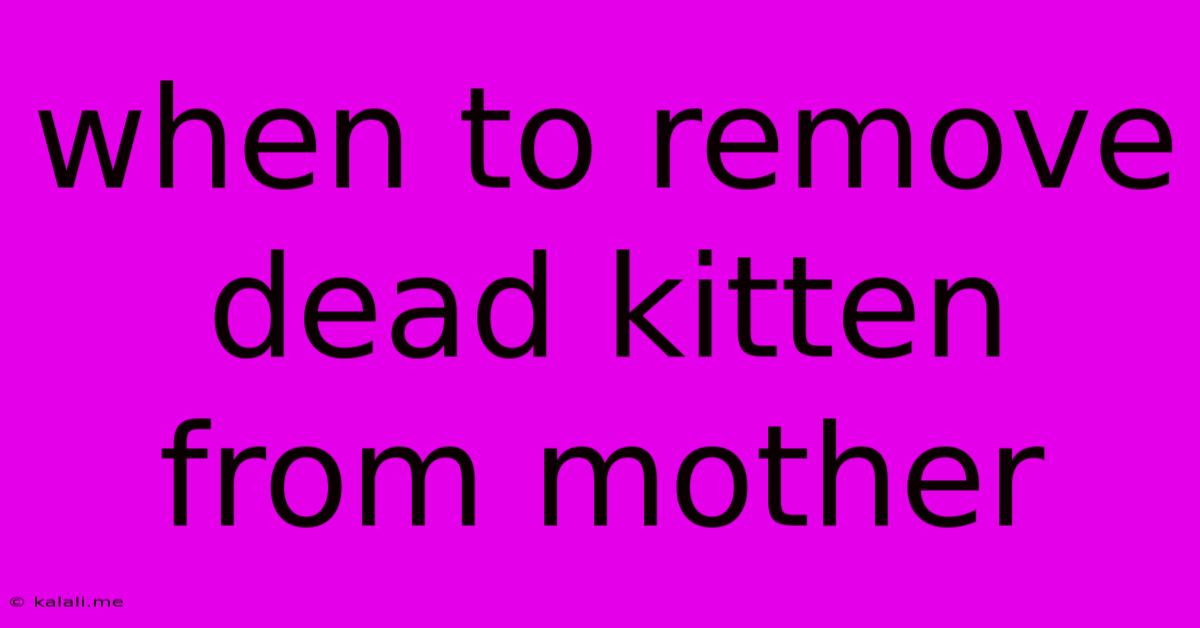When To Remove Dead Kitten From Mother
Kalali
May 24, 2025 · 3 min read

Table of Contents
When to Leave a Stillborn Kitten and When to Remove It
Losing a kitten is devastating, especially for a mother cat. Knowing when to intervene and when to allow nature to take its course is crucial for both the mother's well-being and the health of any surviving kittens. This guide explores the complexities of this sensitive situation, offering guidance on how to best support both the mother cat and her litter.
Understanding a Mother Cat's Instincts
Mother cats, or queens, are generally very good at caring for their young. They instinctively know when a kitten is no longer viable. Often, a queen will naturally move a deceased kitten to the edge of the nest or completely away from her living kittens. This behavior is their way of self-preservation and protection of their healthy offspring. The presence of a dead kitten can attract insects, bacteria, and potentially contaminate the nest, leading to disease and infection in the surviving kittens.
Signs a Kitten is Stillborn or Deceased:
- Lack of movement or breathing: This is the most obvious sign.
- Cold to the touch: A deceased kitten will lose its body heat quickly.
- Limp body: A stillborn kitten will lack the muscle tone of a living kitten.
- No heartbeat or pulse: Check gently for a faint heartbeat near the kitten's chest.
- Discoloration: The kitten's skin may appear discolored or mottled.
When to Intervene and Remove a Dead Kitten:
While a mother cat will usually handle the removal herself, there are instances where intervention is necessary:
- The mother cat shows no sign of moving the deceased kitten: If the queen shows no interest in moving the dead kitten after several hours, it's best to intervene. Leaving it in the nest poses a risk of infection for the surviving kittens.
- The mother cat is excessively stressed or unwell: A stressed or sick mother cat may be unable to cope with the loss and maintain the hygiene of the nest. Removing the dead kitten in these cases is crucial.
- The presence of multiple stillborn kittens: If there are multiple deceased kittens, the risk of infection to the healthy kittens becomes significantly higher. Removing them promptly minimizes this risk.
- The mother cat is neglecting her living kittens: Sometimes the trauma of a stillborn kitten can cause the mother to neglect the living ones. If this is the case, the dead kitten should be removed and the mother assessed by a veterinarian.
How to Remove a Deceased Kitten Gently:
- Wear gloves: This protects you from potential bacteria and diseases.
- Use a clean cloth or tissue: Gently wrap the kitten in a clean cloth or tissue before removing it from the nest.
- Dispose of the kitten appropriately: Wrap the kitten securely and place it in a sealed plastic bag. Dispose of it according to your local regulations. Some people bury them in their garden, but you should be mindful of local regulations.
When to Leave the Kitten:
If the mother cat displays signs of moving the stillborn kitten herself, or if she has already moved it away from her living kittens, it's usually best to allow her natural instincts to guide her. Observing her closely is key. However, always prioritize the health and safety of both the mother cat and her surviving kittens.
Important Note: If you are concerned about the mother cat's behavior or the health of her kittens, always consult a veterinarian. They can provide expert advice and ensure the well-being of your feline family. Remember, a sensitive and observant approach is key to handling this challenging situation with compassion.
Latest Posts
Latest Posts
-
How Far Can You Drive On A Donut
May 24, 2025
-
Why Were The People In Mexico Crawling In Breaking Bad
May 24, 2025
-
How To Keep Mice Out Of House
May 24, 2025
-
Condensation Point Temperature In Fahrenheit For Water
May 24, 2025
-
Difference Between Scotch Whiskey And Bourbon
May 24, 2025
Related Post
Thank you for visiting our website which covers about When To Remove Dead Kitten From Mother . We hope the information provided has been useful to you. Feel free to contact us if you have any questions or need further assistance. See you next time and don't miss to bookmark.